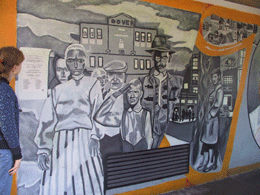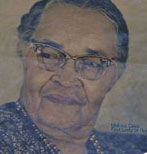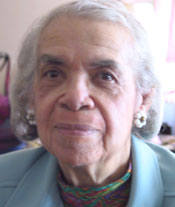|


 n
the cityscape of Black Boston over the past eighty–three
years two civic associations have stood out as fixtures
of social and cultural life. n
the cityscape of Black Boston over the past eighty–three
years two civic associations have stood out as fixtures
of social and cultural life.
Both of these venerable and enduring institutions—the
Women’s Service Club and the  League
of Women in Community Service-- continue to
flourish and co-exist side by side at this writing. League
of Women in Community Service-- continue to
flourish and co-exist side by side at this writing.
Though the two clubs are well known and respected,
the question of precisely what role they have played
in the promotion of cultural life has not been explored
or precisely documented.
Adelaide Cromwell, in her sociological study
of Boston’s black upper class, calls them
“charitable-social, local, non clique limited
clubs” and deems them “extremely important
institutions in Boston” (143)--presumably
because they are indigenous to the city, not chapters
of organizations founded elsewhere.
“Non clique” means, one supposes, that
they are open to new applicants for membership.
Though it is known locally that James Weldon Johnson
and Roland Hayes, to name just two luminaries, made
featured appearances at the League of Women for
Community Service, there is little systematic documentation
that would allow us to gauge the linkage between
the social service mission of the club and the genesis
of cultural capital in Black Boston.
The year 1918 is cited as the beginning for both,
though their dates of legal incorporation would
differ. Cromwell found that
“[b]y 1950, roughly thirty years after
the founding of both clubs, the services performed
by both were quite similar—a modest amount
of social service, the use of either building
for outside events, the use of a few rooms for
students, and the continuation of a feud between
them.“
To the outsider trying to comprehend how two clubs
could grow up nearly side by side and endure for
eighty years and counting, these two associations
appear maddeningly similar. One wonders why, if
their activities mirrored each other so closely,
they would not either merged for fiscal benefit
or differentiated so as to be more complementary.
Their location in the elegant South End, a short
walk south of Symphony Hall, the Christian Science
Mother Church and Mapparium, and Horticultural Hall,
places them at Boston’s architectural and
cultural heart.
The Women’s Service Club at 464 Massachusetts
Avenue occupies an elegant three-story town house,
while the League (“558”) is headquartered
in a stunningly ornate Victorian mansion. Their
nicknames, accordingly, are “464” and
“558.”
The stimulus for their formalization came out of
the desire of black women to contribute to the war
effort. But they already existed as private affinity
clubs, one around the activity of bridge and the
other around knitting. Their real differences, surmises
Cromwell, were social,
“rooted in conflicts among individuals,
which antedated the formal origin of either [organization]”
.... [a] certain tragic aspect is involved in
their development, for the accomplishments in
organizing both groups at the time are still
unique among Negro women at this writing”
(147).
But perhaps there is no tragedy in the fact that
two strong and autonomous black women’s organizations
have thrived and lent coherence to the development
of a vibrant and historic community.
Discussions with present-day members and others
acquainted with the history provide the material
for only the broadest comparisons, in which 558
emerges as the association focused primarily on
cultural events, counting on its “well-to-do”
members whose husbands originally “wrote the
checks.”
In contrast, 464 may have taken the lead in “hands
on” social involvement, preparing Thanksgiving
baskets, running a food bank and often “going
into its pockets” to carry out such programs.
Not that they stood alone in this respect. Other
black organizations functioning through the same
times were socially oriented as well—perhaps
more so, as suggested by Ruth Batson, a leader
in education for decades in the city of Boston.
Batson recalls that
“[t]here were many women’s organizations
in the early days: The group at 464 and the one
at 558, which tended to be more la-de-da. I was
never interested in joining these organizations.
I was more interested in the fight for freedom.”
Batson’s own activism stems from her family’s
involvement in the Garvey movement, strong
in Boston during the 1920s and 1930s.
Other individuals, such as the daughters of activist
Florence Le Sueur, do not draw a sharp distinction
between one or the other of the two organizations,
but seeing them both as being socially concerned.

They remember that 558, like the Harriet Tubman
House fostered by their mother’s activism,
helped newcomers find work in defense plants, starting
in 1939 and located openings for live-in maids in
Cambridge at the homes of Harvard professors.
One could add to the list of organizations devoted
to community service the Robert Gould Shaw House
(one of “the settlements,”) as important
organizations adding strength to the social fabric.
Myra McAdoo, both of whose grandmothers
were founding members of 464, is the group’s
historian, preparing historical summaries every
five years.
According to McAdoo, whose mother Gladys was a prominent
member too, it is not the case that 464 and 558
had the same functions, even though they were not
always separate. During World War I they combined,
but afterwards “couldn’t decide who
would be President.” Some of the members left
464 and went to 558, like Gladys McAdoo’s
“bridge buddy Emma Newman.” Today McAdoo
sees “The League” at 558 as concerned
with cultural events.
McAdoo’s own group, the Women’s Service
Club at 464 is devoted to hands on work. It began
as “Mrs. Mary Wilson’s knitting club,”
Mary Wilson being the wife of attorney Butler R.
Wilson.
At first 464 had its own building, “The
Rest House,” at the Columbus Avenue playground.
An 80th anniversary program put out by “464,”
states that the club was incorporated on December
3, 1919 .
“On March 1, 1920, the ladies raised all
the money and in early days went into their own
pockets to maintain the building and to provide
the necessary services. They even cleaned the
buildings themselves........[t]he Charter members
were culturally, socially, and economically mixed
and met today’s definition of ‘diversity.’”
This intriguing comment on diversity, according
to Myra McAdoo, means that “We had black and
white women, rich and poor, you name it, we had
one.” Myra’s two grandmothers were founding
members: “One was short and Catholic (Katie
Gallagher McAdoo). The other, Mattie, was tall,
Episcopalian, white, and sang in eight languages.”
Whether 464 adopted an issues-oriented or political
stance in its early decades rema ins
to be researched. What is clear is that when Melnea
Cass (1896-1978) assumed the presidency of 464,
she placed political activism high on the agenda. ins
to be researched. What is clear is that when Melnea
Cass (1896-1978) assumed the presidency of 464,
she placed political activism high on the agenda.
Cass, known as the “First Lady of Roxbury,”
encouraged women to vote in the 1920s, and in the
1930s successfully pressured department stores and
hospitals to hire African Americans.
According to Adelaide Cromwell,
“[464] is generally credited with rendering
effective, widely recognized service, entertaining
soldiers on the way to and from army posts, supplying
many needs of servicemen, and educating and stimulating
a war-depressed community.”
One misses the concrete detail here, the description
of what those contacts might have been like, who
the women were, and how they might have interacted
with servicemen from all parts of the United States,
some of them green recruits, others shell-shocked
from war. It’s easy to picture their nimble
fingers turning out woolen hats, gloves, and socks
for the World War I servicemen stationed at nearby
Camp Devens, traveling by train for formal
visits, providing cigarettes as well, at a time
when tobacco was thought to be a fairly harmless
habit.
Originally a temporary cantonment area, the Camp
Devens army post, according to its Web site, came
into existence on September 5, 1917, on land purchased
from individuals in the towns of Ayer, Harvard,
Shirley, and Lancaster, about an hour’s drive
from Boston.
Two divisions of more than 100,000 soldiers trained
at Camp Devens (the 76th and the 12th) between August,
1917 and November, 1918. In 1918 it became a separation
center for over 150,000 troops upon their return
from France. The camp would definitely have been
in need of support for the servicemen for reasons
beyond the usual ones. In September 1918, it was
facing a terrible epidemic of what was later diagnosed
as Spanish influenza. A doctor stationed at Camp
Devens, which was also the base hospital for the
Northeast, wrote to a friend, and fellow physician,
stating that his surgical unit was sustaining fifty
deaths every day. He described the onset of the
illness as what at first appeared to be
“an attack of la grippe or influenza. .
. , and when brought to the hospital they very
rapidly develop the most viscous type of pneumonia
that has ever been seen. Two hours after admission
they have the mahogany spots over the cheek bones,
and a few hours later you can begin to see the
cyanosis extending from their ears and spreading
all over the face, until it is hard to distinguish
the coloured men from the white. It is only a
matter of a few hours then until death comes,
and it is simply a struggle for air until they
suffocate. It is horrible. . . We have been averaging
about 100 deaths per day, and still keeping it
up.
The disease, also called “the Spanish lady,”
claimed victims in Boston too: as September 1918
drew to a close, the city had lost more than 1000
people. One can only imagine the trepidation of
the women as they knitted, sized, and stitched woolen
items for the servicemen, with autumn advancing
and winter chill on the way. It wasn’t until
early November that the flu virtually disappeared
from Boston.
In order to describe in more detail what went on,
we would need information on whether “464”
had direct contacts with the colored men at the
Camp or at their headquarters in Boston, whether
they worked in conjunction with black YWCA leaders
such as Caroline Bond Day and Addie Hunton, who
were engaged in similar wartime work in New York
and elsewhere. Further, did the members themselves
have sons and husbands at Camp Devens or on the
fields of France? Were there love stories that deserve
to be included in the pages of history?
558
The second organization, the League
of Women for Community Service, or “558”,
was started as a bridge club, which, according to
Adelaide Cromwell, “Mrs. Wilson [founder of
‘464'] hadn’t been invited to join.”
Why wouldn’t she have been invited, one wonders.
Was there a disagreement between Mary Wilson and
Maria Baldwin, who served as 558’s first President
from 1918-1922?
Wilson’s social standing as wife of attorney
Butler R. Wilson, was high. Perhaps she was perceived
as a snob, someone of old roots who lorded it over
those who didn’t have them? Did Baldwin and
Wilson have different ideas about how to pursue
black progress? Did some have ties with William
Monroe Trotter’s family, which embraced a
more militant philosophy than local supporters of
Booker T. Washington? The question is an important
and intriguing one.
According to historian Robert C. Hayden,
the women met socially in each other’s homes
for Sunday afternoon tea.
It was a time (1918)
“[w]hen World War I gripped the country,
when Southern agriculture declined and when war
related industry jobs were plentiful all at the
same time, [and] Black Americans moved in large
numbers from the South to the North. Many coming
to the Boston area were black soldiers stationed
at the Fort Devens Army Base in nearby Ayer.”
The women’s group set up their “Soldier’s
Comfort Home” on the site of the present
William D. Carter playground on Columbus Avenue.”
Their leader, Maria L. Baldwin (1856-1922),
was a brilliant lecturer, often speaking against
racial discrimination and praising the achievements
of Black Americans. After retiring from her post
as Head of the Agassiz School in Cambridge, Baldwin
moved to the South End--for what would be the last
four years of her life. At first the women first
rented storefront space at 528 Massachusetts Avenue,
then proceeded to purchase a Victorian row house
mansion that had been owned by an abolitionist.
The symbolism of the place was strikingly apt:
Five-fifty eight Massachusetts Avenue was built
in 1860 by John Farwell, a wealthy white
sea captain and shipping merchant. Farwell was an
active abolitionist and he used his home as a station
of the Underground Railroad in Boston to hide fugitive
slaves. When federal officials came to Farwell’s
home in search of a runaway slave a secreted ‘hidden
room’ was used to hide the slaves and it has
been speculated though not documented that a secret
passageway was used to move them into the home next
door at 560 Mass Ave.
Because of its place in the history of the abolitionist
movement, ‘558’ has been named as a
member of the National Register of Historic Places.
At the May 1, 1919 meeting the women voted to change
the name of their organization from “Soldiers
Comfort Unit” to the League of Women for Community
Service, to take effect in 1920 when they became
incorporated.
Maude T. Jenkins, in her study of the Black Woman’s Club Movement
in America, describes the building at 558, built
in 1860, as having “marble fireplaces, French
gold leaf chandeliers, a ballroom and library, fine
iron work around the windows, massive mahogany staircases
and doors, Corinthian columns, elaborate plaster
work, huge Venetian mirrors on the walls, silver
doorknobs and beautiful Victorian furniture.”
in her study of the Black Woman’s Club Movement
in America, describes the building at 558, built
in 1860, as having “marble fireplaces, French
gold leaf chandeliers, a ballroom and library, fine
iron work around the windows, massive mahogany staircases
and doors, Corinthian columns, elaborate plaster
work, huge Venetian mirrors on the walls, silver
doorknobs and beautiful Victorian furniture.”
Under Maria Baldwin’s leadership, explains
Hayden,
“receptions for black soldiers returning
home to Boston and regular visits to Soldiers
at Fort Devens with knitted sweaters, candy,
and cigarettes were carried out by the women.
The Soldiers and Sailors Visiting Committee existed
‘to carry comfort and cheer to soldiers
and sailors in [m]any camps.’”
In their mission rhetoric the women made it clear
that they were focused on the needs of African American
men. A Junior Comfort Unit was established
‘to draw the attention of the younger
people to the need of work also among them for soldiers
and to cooperate in the patriotic service we are
trying to render the race." [emphasis added]
After World War I, 558 provided housing and assistance
to young black women arriving to attend college,
and also assisted Southern girls and women seeking
positions as domestic workers.
What did it take to become a member of 558?
According to Cromwell, the LWCS stressed “old
Boston residence and educational qualifications.”
With headmistress Maria Baldwin as President, the
educational part makes sense. What might be meant
by “old Boston residence,” though? This
antiquity requirement could be read as a devotion
to honoring Boston’s special history as home
of the Abolition Movement and earliest northern
black settlement—a devotion that approached
the fervor of religiosity in this hidebound Boston
community. Or, alternatively, it could refer literally
to the length of one’s family’s presence
in the city of Boston, though long bloodlines were
the exception rather than the rule. Perhaps it meant
both.
Mission statements, activity papers, and minutes
of the meetings are needed to assess more fully
the importance of both 558 and 464. There are more
questions than answers at this point. What about
the role of men’s associations that contributed
to developing cultural life? (Cromwell’s study
is limited by gender to females).
Cultural Considerations
Both clubs hosted all manner of meetings, concerts,
lectures, and allowed usage of their space for rehearsals.
In so doing, they would have created an auspicious
environment in which a climate self-reflective of
black culture could develop. But as private clubs
they would have placed conditions on such usage.
What might their criteria have been? One surmises
that a kind of social propriety derived from the
women’s Black Brahmin ethos would have been
important. How would the women have decided who
should be allowed to present or use their space?
During this era, when W.E.B. DuBois proclaimed that
the future belonged to “the talented tenth”
and Alain Locke, in 1925, hailed “The New
Negro,” it’s likely the women would
have favored uplift discourse and worried about
plays with overt social criticism or political content.
Minstrel shows or performances of a risquÈ
nature would be antithetial to their purpose, one
would think. Perhaps the singing of spirituals,
meetings of Pan-Africanist sentiment, and plays
spoken in dialect would have stirred discussion
among the members or on the Board of Directors.
How important was it for the organization to have
events conform? What were membership dues, and what
were the usage fees and how would they have had
the effect of regulating access?
But what is important to emphasize is that the events
sponsored and held at 558 and 464, whether musical,
oratorical, artistic or dramatic, would have tended
to lift people out of daily life, and to further
define a sense of community.
|


